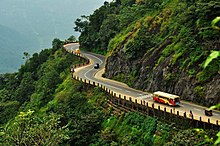Karinthandan is a legendary figure in the history of Wayanad, a district in the Indian state of Kerala. He is revered as a tribal chieftain who sacrificed his life to protect his people and their land.[1][2][3] tris.[4][5]

Legend
editAccording to the local legend, Karinthandan was a member of the Paniya tribe, which was known for its deep knowledge of the forests and the mountains of Wayanad.[6] When the British East India Company began its colonial expansion into the region in the 17th century, they sent a team of engineers to survey the area for a road construction.[7]
As the team made its way through the dense forests and steep mountains of Wayanad, they relied heavily on the guidance of Karinthandan and his tribe. The Paniya people were skilled hunters and gatherers who knew the land well. They led the team through treacherous terrain, and eventually, they reached the summit of the Churam mountain pass, which connects Wayanad to the neighboring district of Kozhikode.[8]
It was at this point that the legend takes a tragic turn. According to local folklore, the Britishers, eager to take credit for discovering the pass, pushed Karinthandan off the cliff to his death. The Paniya people were devastated by the loss of their leader, who they regarded as a hero and protector of their land.[8][9]
Legacy
editThe legend of Karinthandan has been passed down through generations and is still an important part of the cultural heritage of Wayanad. The Paniya people continue to tell the story of their hero, and many consider him a martyr who gave his life to protect his people and their land. The story of Karinthandan also reflects the complex relationship between the indigenous tribes of Wayanad and the colonial powers that sought to control the region.[4][5]
In recent years, there have been efforts to preserve the memory of Karinthandan and Recognize his contribution to the history of Wayanad. In 2015, the Kerala government announced plans to build a statue of Karinthandan at the Churam pass to honor his memory. The project has been controversial, with some activists and tribal leaders arguing that the statue would be a form of cultural appropriation and would disrespect the memory of Karinthandan.[10]
Chain tree
editAs Karinthandan lay dying, he placed a curse on the forest and the mountain pass, saying that no one who betrayed another in the region would ever find their way back home. Legend has it that Karinthandan's spirit remained in the forest, and his soul was trapped in a nearby fig tree, which later became known as the Wayanad Chain Tree.[11][12][13]
The tree is named after the chains that are wrapped around it, which are said to have been placed there by a British engineer who got lost in the forest and was unable to find his way out until a local tribal elder led him to the tree.[14] The elder explained the legend of Karinthandan and the curse, and told the engineers that the only way to lift the curse was to perform a ritual by tying a chain around the tree three times and making a wish.[12]
Today, the Wayanad Chain Tree is a popular tourist attraction, and visitors come from all over to see the tree and learn about the legend of Karinthandan. The tree is located in a beautiful forested area, and there are several trails and viewpoints nearby that offer views of the surrounding mountains and valleys.[15]
In popular culture
editKarinthandan's story has been passed down through generations as part of the folklore and cultural heritage of the Wayanad region of Kerala, and has therefore been featured in various forms of popular culture.
One example is the Malayalam novel "Karinthandan" by Sanal Krishnan, which was published in 2021.[16][17] The novel tells the story of Karinthandan and explores his thoughts, emotions, and motivations as he guides British engineers through the forests of Wayanad. In addition to literature, Karinthandan's story has also been featured in local art forms such as theatre, dance,movie, and music.[18]
References
edit- ^ "Memorial tribute to Karinthandan, on whose steps 'pilgrims' still walk". The Times of India. 2021-11-07. ISSN 0971-8257. Retrieved 2023-03-24.
- ^ Mannewar, Prafulla (2021-02-14). Curiously Wandering. Notion Press. ISBN 978-1-63714-511-1.
- ^ Markose, Baiju (2018-01-11). Rhizomatic Reflections: Discourses on Religion and Theology. Wipf and Stock Publishers. ISBN 978-1-5326-3085-9.
- ^ a b Bandhu, P.; Jacob, T. G. (2019-08-01). Encountering The Adivasi Question: South Indian Narratives. Studera Press. ISBN 978-93-85883-92-7.
- ^ a b "വയനാടന് ചുരത്തിന്റെ കഥ; കരിന്തണ്ടന്റെയും". 2014-02-06. Archived from the original on 2014-02-06. Retrieved 2023-03-24.
- ^ "Tribal hero of Thamarassery Ghat road gets a face". The Times of India. 2014-07-25. ISSN 0971-8257. Retrieved 2023-03-24.
- ^ "ഒരു കരിന്തണ്ടൻ വീരഗാഥ". 2018-06-21. Archived from the original on 2018-06-21. Retrieved 2023-03-24.
- ^ a b "ആരാണ് "കരിന്തണ്ടന്" ?". ആരാണ് “കരിന്തണ്ടന്” ?. Retrieved 2023-03-24.
- ^ "വയനാടന് ചുരത്തിന്റെ കഥ; കരിന്തണ്ടന്റെയും…". ആനവണ്ടി ട്രാവൽ ബ്ലോഗ് മലയാളം Aanavandi Travel Blog Malayalam. Retrieved 2023-03-24.
- ^ "The story of Karinthandan and his martyrdom". English.Mathrubhumi. Retrieved 2023-03-24.
- ^ Srivastava, Priya. "The haunted tale of chain tree in Kerala's Wayanad will keep you awake all night long!". The Times of India. ISSN 0971-8257. Retrieved 2023-03-24.
- ^ a b Kumar, Varman, Tiwary, Ajit, Raj, Sachin (9 September 2017). "A Reappraisal of Rock‐art at Vellarikombi and its Kurumba Association and Continuity" (PDF). Heritage: Journal of Multidisciplinary Studies in Archaeology. 5 (1): 244‐260.
{{cite journal}}: CS1 maint: multiple names: authors list (link) - ^ "The Kerala News, Latest Kerala News, Kerala News Epaper Online". 2013-07-26. Archived from the original on 2013-07-26. Retrieved 2023-03-24.
- ^ "Hope to change ideas about tribal people with 'Karinthandan': Director Leela Santhosh". The News Minute. 2018-07-05. Retrieved 2023-03-24.
- ^ "CHAIN TREE OF KARINTHANDAN (Vythiri) - All You Need to Know BEFORE You Go". Tripadvisor. Retrieved 2023-03-24.
- ^ "കുട്ടിക്കാലം മുതൽ പറഞ്ഞു കേട്ട കരിന്തണ്ടന്റെ കഥ". ManoramaOnline (in Malayalam). Retrieved 2023-03-24.
- ^ "KARINTHANDAN". Olive Publications. Retrieved 2023-03-24.
- ^ "A Malabar Story". connectingheritage.com. Retrieved 2023-03-24.